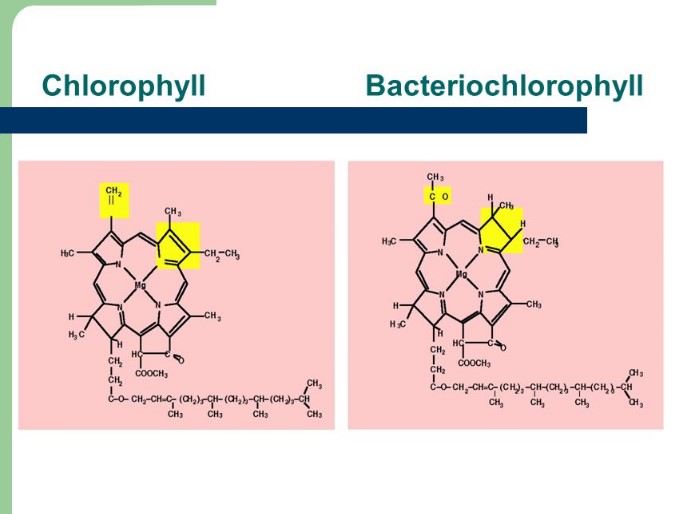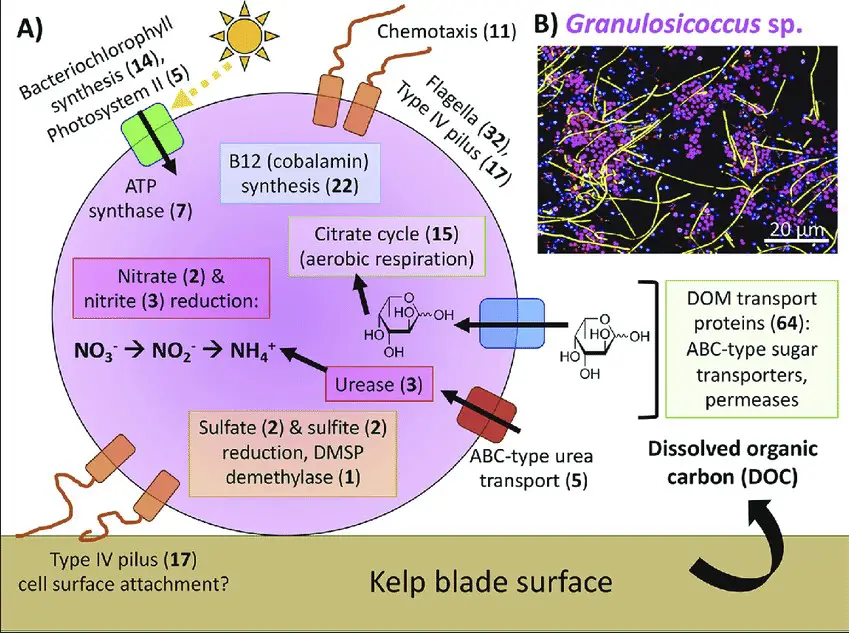Photosynthesis is a fundamental process that sustains life on Earth, relying heavily on pigments that capture light energy. Among these pigments, chlorophyll is well-known for its role in plants, algae, and cyanobacteria, where it facilitates the conversion of sunlight into chemical energy. Less commonly discussed but equally fascinating is bacteriochlorophyll, a pigment found in certain photosynthetic bacteria. These pigments are not only pivotal in their ecosystems but also serve as crucial components of the photosynthetic machinery.
Chlorophyll and bacteriochlorophyll are both essential for photosynthesis, but they differ significantly in their chemical structure and the specific wavelengths of light they absorb. Chlorophyll mainly captures blue and red light, playing a key role in oxygenic photosynthesis in plants, while bacteriochlorophyll absorbs light in the infrared spectrum, which is vital for anoxygenic photosynthesis in some bacteria. These differences reflect adaptations to their distinct environmental niches and functional roles.
Exploring these pigments reveals variations tailored by nature to optimize energy capture under diverse conditions. From the basic chemical framework to the nuanced differences in light absorption, these molecules showcase the elegance of evolutionary adaptation. Understanding their structures and functions not only deepens our knowledge of biological processes but also enhances our ability to harness these mechanisms for technological applications.

Chlorophyll Basics
What is Chlorophyll?
Chlorophyll is a vital pigment found predominantly in plants, algae, and cyanobacteria. This pigment is essential for photosynthesis, the process by which these organisms convert light energy into chemical energy. Chlorophyll’s main role is to absorb light, usually sunlight, to initiate this energy transformation.
Role in Photosynthesis
Chlorophyll plays a central role in the photosynthetic process by:
- Absorbing light energy: Chlorophyll captures light primarily in the blue and red wavelengths.
- Converting energy: The absorbed light energy is converted into chemical energy in the form of ATP and NADPH.
- Producing sugars: The energy produced is used to transform carbon dioxide (CO2) and water (H2O) into glucose and oxygen.
This process is fundamental to the life cycle of plants and many microorganisms, as it provides the necessary energy and organic materials for growth.
Types of Chlorophyll
There are several types of chlorophyll, each with a unique structure and function:
- Chlorophyll a: This is the most common type and is essential for initiating the reaction in photosynthesis.
- Chlorophyll b: It assists in capturing light energy and passes it to chlorophyll a.
- Chlorophyll c: Found in certain algae, it helps in absorbing additional light frequencies.
- Chlorophyll d: It is present in some cyanobacteria and is adapted to absorb far-red light beyond the range of chlorophyll a.
Bacteriochlorophyll Overview
What is Bacteriochlorophyll?
Bacteriochlorophyll is another type of photosynthetic pigment, primarily found in various photosynthetic bacteria, including purple and green sulfur bacteria. Unlike chlorophyll, bacteriochlorophyll absorbs light in the infrared spectrum, which is less competitive than the visible spectrum absorbed by chlorophyll.
Function in Bacteria
The primary function of bacteriochlorophyll is to facilitate photosynthesis in environments with less light or different light qualities. This allows photosynthetic bacteria to thrive in unique and often extreme environments, such as:
- Deep-water zones: Where little light penetrates.
- Hot springs and thermal vents: Where available light shifts towards the infrared spectrum.
Types and Differences
Bacteriochlorophyll comes in several forms, each adapted to specific environmental conditions and bacterial species:
- Bacteriochlorophyll a and b: Common in most photosynthetic bacteria, absorbing different spectra of infrared light.
- Bacteriochlorophyll c, d, e, and g: Found in specific bacteria, these variants further extend the range of environments where photosynthesis can occur.
Chemical Structures
Chlorophyll Structure
Chlorophyll molecules have a magnesium ion at the center of a large ring structure known as a porphyrin. This complex structure allows it to effectively capture light.
Bacteriochlorophyll Structure
Bacteriochlorophyll also contains a magnesium ion, but variations in its porphyrin ring and side chains alter its light absorption properties, making it more effective in different light conditions.
Comparative Analysis
The structural differences between chlorophyll and bacteriochlorophyll are significant because they reflect the adaptation of each pigment to specific ecological niches and light conditions. The modifications in bacteriochlorophyll allow it to capture light that chlorophyll cannot, providing a competitive advantage in certain environments.
Absorption Spectra
Chlorophyll Absorption
Chlorophyll absorbs light most efficiently in the 400–700 nm range, which includes the high-energy blue and the lower energy red light. This range is optimal for photosynthesis in terrestrial and shallow-water environments.
Bacteriochlorophyll Absorption
In contrast, bacteriochlorophyll primarily absorbs light in the infrared spectrum, around 800–1000 nm. This adaptation allows bacteria containing bacteriochlorophyll to perform photosynthesis in dimly lit environments, such as deep waters and sediments.
Spectral Differences
The spectral differences between chlorophyll and bacteriochlorophyll are crucial for their respective biological roles. Each pigment is tuned to the specific light environment of its organism, ensuring optimal energy capture for photosynthesis. These adaptations illustrate the diversity and specialization of life forms depending on their environmental conditions and available resources.

Biological Functions
Chlorophyll in Plants
Chlorophyll is crucial for plants, not only for its role in photosynthesis but also for its involvement in growth and health. In plants, chlorophyll absorbs sunlight and uses its energy to synthesize carbohydrates from CO2 and water. This process is not only pivotal for the growth of the plant itself but also indirectly supplies oxygen, which is essential for life on Earth. Beyond its primary role, chlorophyll also influences a variety of growth processes which are hormone-regulated.
Bacteriochlorophyll in Microorganisms
In microorganisms, bacteriochlorophyll plays roles that extend beyond mere energy production. These pigments enable bacteria to inhabit and thrive in environments that are devoid of sunlight, such as deep sea vents or under layers of sediment. Bacteriochlorophyll-based photosynthesis supports various microbial communities by providing them with the necessary energy to form organic compounds, which are crucial for their survival in nutrient-poor habitats.
Environmental Adaptations
Chlorophyll and Light Conditions
Chlorophyll’s adaptability to different light conditions is a testament to its evolutionary success. In plants, chlorophyll concentrations adjust depending on light intensity:
- In high light environments, plants may have less chlorophyll per unit area to prevent damage caused by excess light.
- In low light environments, plants typically increase chlorophyll content to maximize light absorption.
This adaptation helps plants optimize their energy production and survive in varying conditions.
Bacteriochlorophyll and Habitats
Bacteriochlorophyll allows bacteria to exploit diverse and extreme habitats. For instance:
- Deep ocean bacteria use bacteriochlorophyll to capture infrared light available at depths where sunlight does not penetrate.
- Thermal vent bacteria utilize bacteriochlorophyll to thrive in high temperatures and low light, converting geothermal energy into usable chemical forms.
These adaptations underscore the role of bacteriochlorophyll in ecological colonization and survival in extreme conditions.
Evolutionary Perspectives
Evolution of Chlorophyll
The evolution of chlorophyll can be traced back to early photosynthetic organisms, likely cyanobacteria, which began harnessing sunlight through simpler pigments that eventually evolved into chlorophyll. This evolution enabled these organisms to efficiently use sunlight, leading to the oxygenation of the Earth’s atmosphere and the subsequent development of more complex life forms.
Evolution of Bacteriochlorophyll
Bacteriochlorophyll likely evolved from chlorophyll by modifying its molecular structure to absorb different light spectra. This adaptation allowed certain bacteria to occupy niches where chlorophyll-based photosynthesis was inefficient, thereby avoiding direct competition with plants and algae.
Comparative Evolution
Comparing the evolution of chlorophyll and bacteriochlorophyll illustrates how life adapts to environmental pressures. Chlorophyll evolution pushed organisms towards surface habitats and clear waters, while bacteriochlorophyll allowed for the colonization of more isolated and extreme environments. These evolutionary paths show how organisms diversify and specialize based on available resources and competition.
Technological Applications
Chlorophyll in Technology
Chlorophyll is widely used in various technologies due to its light-absorbing properties. Notably, it is used in:
- Solar cells: Engineers mimic the natural process of photosynthesis using chlorophyll to improve the efficiency of solar cells.
- Medical therapies: Chlorophyll is utilized in photodynamic therapy for treating cancer. Its ability to absorb light is harnessed to activate drugs that target cancer cells without harming surrounding healthy tissue.
Bacteriochlorophyll in Biotech
Bacteriochlorophyll’s unique properties find applications in biotechnology, particularly in areas where infrared light can be harnessed:
- Biomedical imaging: Bacteriochlorophyll derivatives are explored for use in imaging technologies that require deeper tissue penetration.
- Renewable energy: Research into bacteriochlorophyll-based solar panels aims to extend the light absorption spectrum, potentially increasing the energy yield from low-light environments.
Frequently Asked Questions
What is Photosynthesis?
Photosynthesis is a biological process used by plants, algae, and certain bacteria to convert light energy into chemical energy stored in glucose, a sugar molecule. This process is crucial for life on Earth as it provides the primary energy source for the food chains.
How does Chlorophyll function in photosynthesis?
Chlorophyll functions in photosynthesis by absorbing light, primarily in the blue and red wavelengths, and converting it into chemical energy through the synthesis of ATP and NADPH. This energy is then used to convert carbon dioxide into glucose.
What makes Bacteriochlorophyll different from Chlorophyll?
Bacteriochlorophyll differs from chlorophyll in its absorption spectrum and molecular structure. It absorbs infrared light, which is beyond the range of chlorophyll, allowing photosynthetic bacteria to thrive in environments with less visible light.
Why is Chlorophyll green?
Chlorophyll is green because it absorbs light most efficiently in the blue and red wavelengths and reflects green light, which is why plants appear green to our eyes.
Can Bacteriochlorophyll replace Chlorophyll in plants?
No, bacteriochlorophyll cannot replace chlorophyll in plants because it absorbs different wavelengths of light and supports a different type of photosynthesis that does not produce oxygen.
Conclusion
The distinctions between chlorophyll and bacteriochlorophyll highlight nature’s ability to adapt and optimize life processes to various environmental conditions. These pigments not only play pivotal roles in their respective organisms but also offer insights into the evolution of photosynthesis. By studying these molecules, scientists continue to uncover the intricate ways in which life on Earth harnesses the power of the sun.
As research advances, our understanding of these complex biochemical processes will improve, potentially leading to innovative applications in biotechnology and sustainable energy solutions. Such studies not only enhance our comprehension of biological diversity and evolutionary biology but also reinforce the importance of preserving varied ecosystems that contribute to global photosynthesis.
